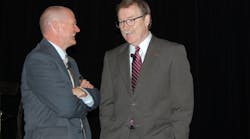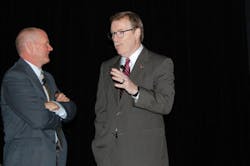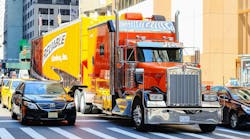Troy Clarke, president and CEO of Navistar, provided his view of trucking’s future – and that of his company, following its alliance with the truck and bus division of Germany’s Volkswagen – during a presentation at annual three-day transportation conference hosted by research firm FTR in Indianapolis.
Clarke touched on a wide variety of subjects, including how “software” will provide the key difference between truck brands now and in the future, how truck buyers will increasingly demand a “one stop shop” for all of their vehicle needs, and how autonomous trucks may one day soon operate like today’s commercial aircraft – largely on autopilot while on the highway, with the driver only controlling the vehicle for “takeoff” and “landing.”
[The video clip below further illustrates Clarke’s perspective on this style of “autonomous” operation.]
“This industry is on the verge of huge technological change,” Clarke noted. “The question for us is; how do we cover all the bets we need to make?”
He said the partnership with Volkswagen is but one effort to “cover” such “bets,” creating in Clarke’s words an “opportunity to accumulate technology and to accumulate scale” for Navistar’s truck manufacturing efforts.
“The truth of the matter is we are excited as all get out about our new partnership,” he emphasized. “It helps us get back on track.” Clarke also noted that such partnerships will be critical moving forward as truck manufacturers shift their strategic thinking away from focusing on the nuts and bolts of commercial vehicles – such as “who has the best gearing or whether to use synthetic lubricant or not,” he noted – and focus instead on how to better “integrate” trucks with the country’s “transportation system."
“This is where the Uberization’ of freight gets involved and how we get the truck to better interact with our road systems,” he explained. That “evolution” also impacts the future development of trucks in terms of safety, environmental impact and freight efficiency, Clarke added.
To meet such various needs, then, will require more of a focus on the truck’s “software” as that is what will link the vehicle better not only to trailers and the road network but to service providers such as dealerships in order to foster faster and less costly repairs.
“This focus on ‘software’ is opening the door of the trucking industry to companies that have never been in this space before: companies like Google and Apple,” Clarke emphasized. “This is also one of the reasons we chose to focus on building ‘connected trucks’ and our OnCommand telematics system. Because we believe connected vehicles are going to be ubiquitous in the future.”
Such “connections” will be critical to improving uptime for customers as well as improving freight efficiency and thus lower operating costs, yet he believes they need to be built on “open architecture” as well.
“The [truck] customer is a hard person to contain – they want the freedom to pick and choose what works for them, much the way we pick and choose what apps we want on our [smart] phones,” Clarke stressed. “That’s why our profit model for connected systems and software is modeled on Apple’s. I just don’t think owning the ‘value chain’ and forcing customers to use it is how this is going to work.”
Taking that view also “opens the door” to new freight solutions, as well, he said, such as electrified medium-duty trucks serving as “mobile platforms” for drones that make package deliveries.
“Here’s the secret: drones cost 7 cents a mile to operate, while a medium-duty truck in zero-emission electric mode costs 21 cents a mile to operate,” he said. “Now compare that to the 57 to 60 cent per mile operating cost of a diesel-powered medium-duty truck or the $1.20 a mile operating cost of a diesel-powered highway tractor-trailer. That’s why you are going to see more diversity and experimentation in freight transport.”




